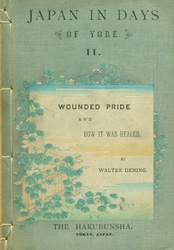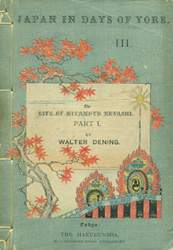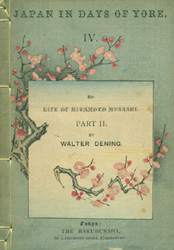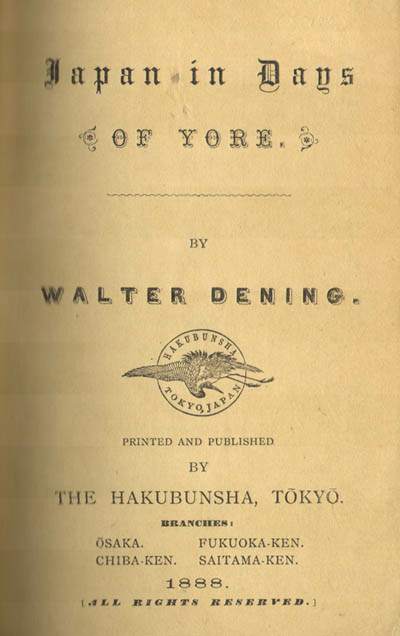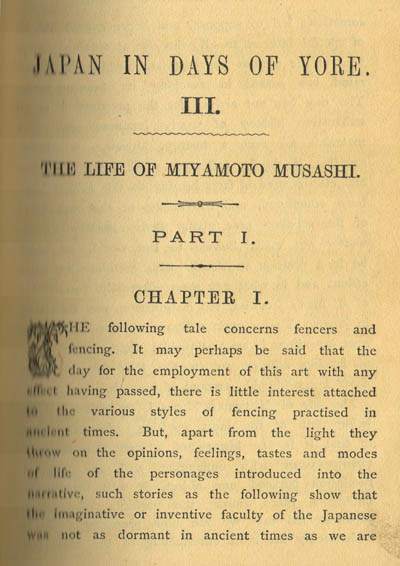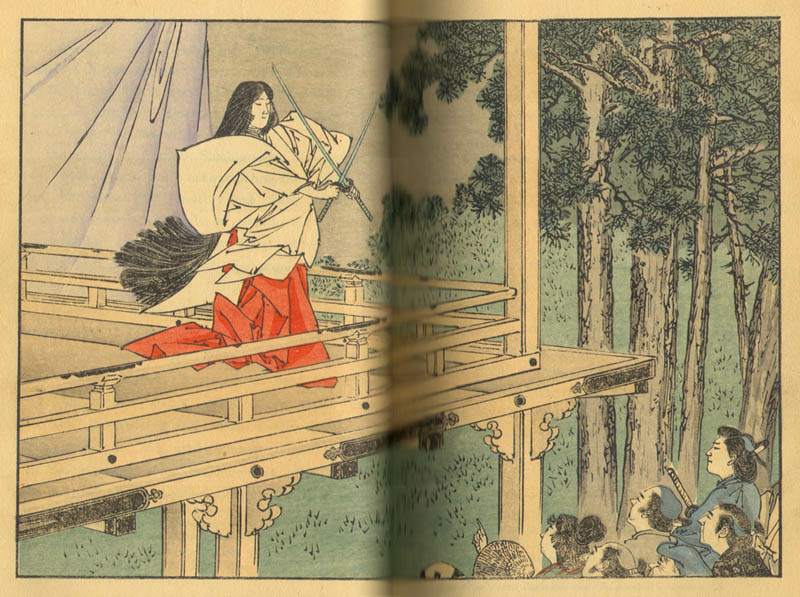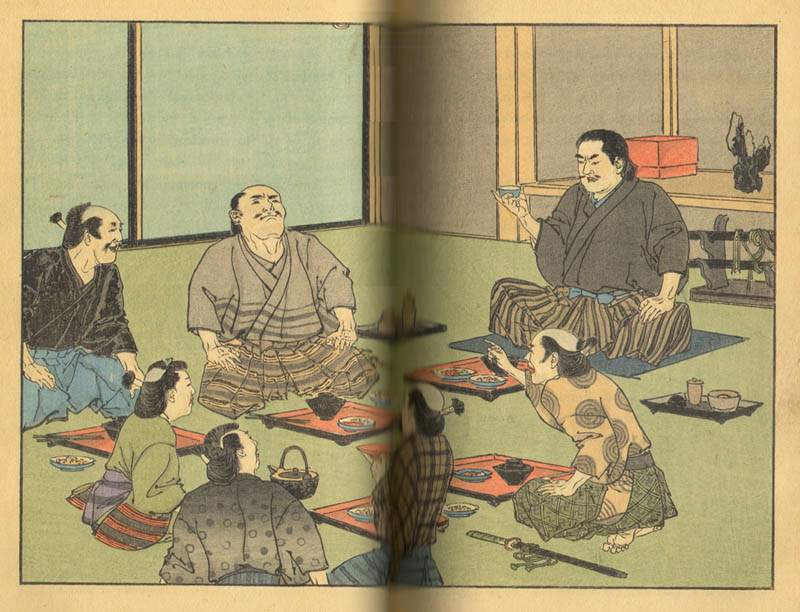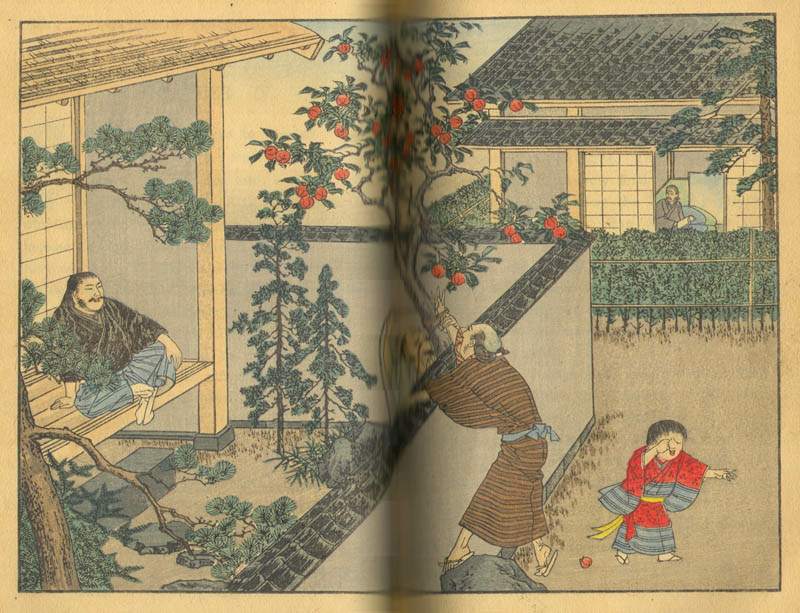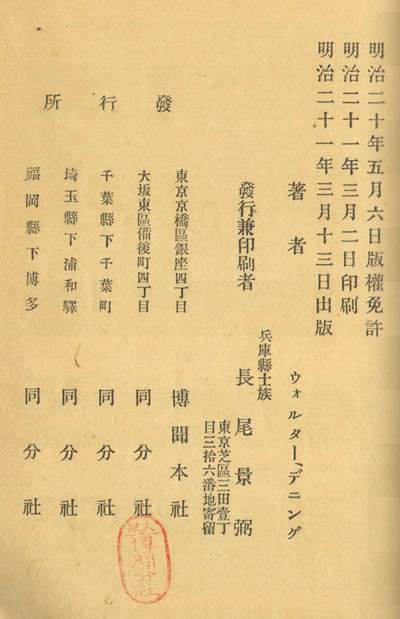|
~~ Book Set 1887080845 ~~Japan in Days of Yore, Part III Walter Dening, 1888
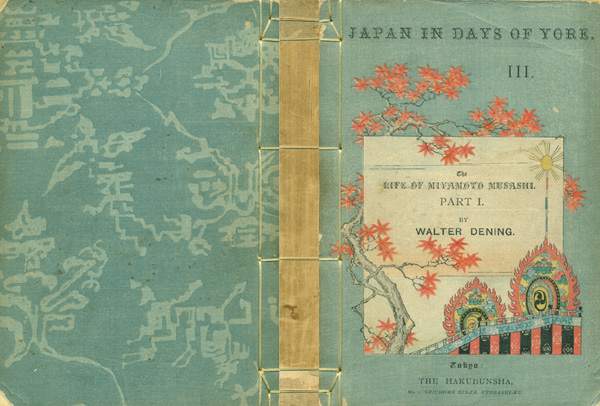
Part I. Very Good. No severed folded pages. Creases to the covers and corners slightly rounded. Last 1/8 of book has a chipped area ca 2 cm long along the fore-edge. For a picture of all four covers as well as all edges, click here. The Life of Miyamoto Musashi, Part I The double page color prints are printed on one side only. It appears that they were printed on a single sheet which was then folded at the middle and bound into the book with the open edges out. The woodblock print pages are not numbered or included in the page count. Wenckstern discusses this set in these terms:
Dening, Rev. W. Japan in Days of Yore. Printed on Japanese paper with many illustrations. In 4 vols. Post 8T, Tokio, 1890. ($ 2.-) (Wenckstern, 1895, at page 96). The advertising in this book as well as The Life of Toyotomi Hideyoshi (1888-90) indicates that the Japan in Days of Yore series was projected to be a six part/volume set. I have confirmed publication of only the first four parts of the set as shown below.
Part I. Human Nature in a Variety of Aspects, 1887, 87 pages. I have found no evidence that parts V and VI were published and I don't believe that they were. Wenckstern's description of the set in 1895 as four volumes appears to be accurate. This set was published with the "Griffith Farran & Co, London, and Sydney, N.S.W." imprint. On these books only the Griffith, Farran & Co. imprint appears on the front cover and title page. There is no mention of Hakubunsha on the front cover or title page. With the exception of the imprint, the covers of these books are essentially the same as the Hakubunsha imprint book. To see the Griffith Farran & Co imprint covers, click here. In 1976 the Fine Book Co., London, published a facsimile edition of Volumes I~IV of this set. The covers of the books reproduced carried the Griffith Farran & Co. imprint. This facsimile edition contained no title pages or colophons. Based upon my general review of library holdings and knowledge of the retail market, I find the Hakubunsha imprint books are reported much less often than the Griffith Farran imprint books. It appears that this set was published in a "trade" type edition which did not have the color prints. I have confirmed such a book for Part IV, The Life of Miyamoto Mushi (second of the two sections). This book has a different cover from the edition with the color prints and is bound with simple string ties rather than the more substantial Kangxi string bindings. To see the front cover, title page and first text page of Part IV of this "trade" edition, click here. Aside from the different covers and lack of plates, the "trade" edition book is identical in format, text and colophon to the edition with color plates. This series was described this way in a 1889 commentary:
A PUBLISHING concern in Tokyo styled the Hakubunsha is preparing to issue a series of translations into English of works by Japanese authors. They will be edited by Mr. Walter Dening, and are to be issued in London by Messrs. Griffith, Farran & Co. Four volumes have appeared of a series entitled 'Japan in Days of Yore,' being a translation of folk-tales illustrating a past age in Japanese life, with a running commentary by the translator oddly introduced here and there into the body of the text. The books are thoroughly Japanese in form. The paper is doubled, and printed on one side only, and the volumes are stabbed and sewn along the back with silk. The illustrations, by Japanese artists, are wonderfully good. The drawing is superb, and very few colors are made to yield effects which would puzzle our chromo-lithographers to produce. The titles of the four volumes are 'Human Nature in a Variety of Aspects,' 'Wounded Pride, and How it was Healed' - a 17th century tale, and 'The Life of Miyamoto Musashi' in two vols. Musashi was a famous fencer of mediaeval times, a sort of Japanese d'Artigan. The Japanese say that they have nothing to learn from European art. As far as book illustrations go, we are almost inclined to admit the truth of their view. Methods differ, and it is not easy to compare the two styles; but the astonishing dexterity, lightness of touch, and assured certainty of producing the required effect by infinitesimal subtleties, patient acquirements of hard study, which the Japanese artists possess, suggest lessons which some of our own book illustrators might profitably take to heart. (The Bookmart, Volume VI, Pittsburgh, Bookmart Publishing Co., June 1888 to May 1889, at page 509). To see the publisher's advertisement for this set found at the rear of Part I, click here. The four parts of this set were published in a "Second Edition" by The Kyo Bun Kwan in 1904-5. The order of Parts I and II is reversed in the second edition from the order in the first edition. The pages in the four parts of the second edition are numbered continuously across the books - beginning at page 1 and ending at page 343 in Part IV. In the first edition, the numbering is restarted at 1 in each part. The first edition is bound using the more elaborate and substantial Kangxi binding string tie technique. The second edition is bound using the simple and flimsy Yotsume Toji binding string tie technique. For more information on this edition, click here. The first volume (text and plates) is on-line here.
The Life of Miyamoto Musashi, Part I
Part III
|
||||||||||||||||||||||||||

